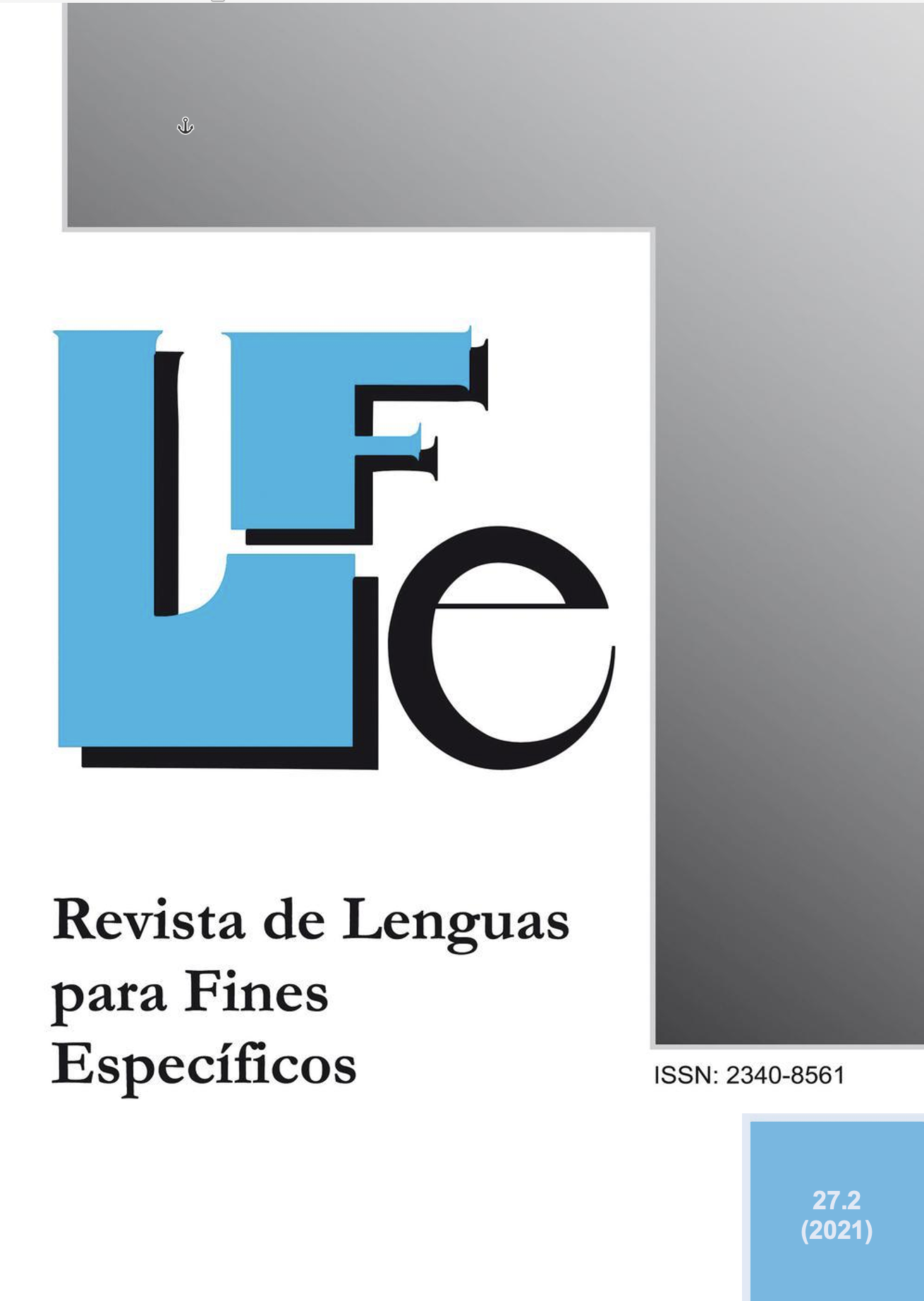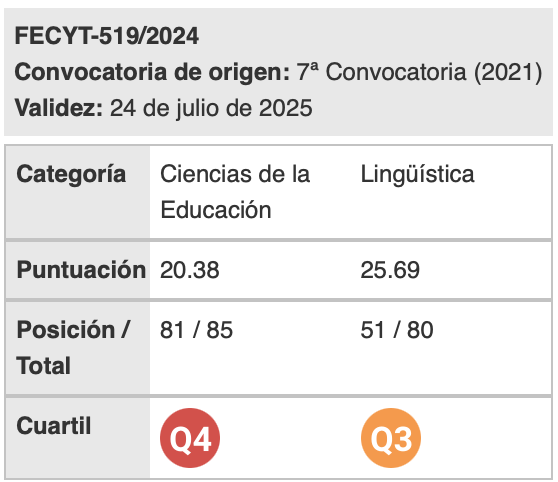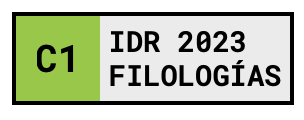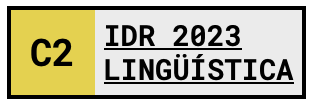Analysis of the verbal voices of the centers of interest "Field work and gardening" and "Fun and sports" in two corpus of Mexican lexical availability
Keywords:
lexical disponibility, interest centers, verbal voices, lexical variations, syllableAbstract
This article aims to analyze the verbal voices of Mexican students in different levels of education: high school and university, and from different periods 2006 and 2014, by their lexical availability index (IDL) and by their syllabic frequency in two corpora (Culiacán and Zacatecas), as part of studies on Mexican lexical availability. A quantitative descriptive type methodology is applied to the lexicon and the syllabic structure of the verbal voices that appear in the Fieldwork and Gardening and Fun and Sports centers of interest. The premise is that the syllabic structure is an important conceptual trigger in the selection and organization of verbs. The results indicate that the CV and CVC syllabic structures are those that most frequently lead to the formation of verbs.
Downloads
References
Aitchison, J. (2012). Words in the Mind: An Introduction to the Mental Lexicon, 4ª ed. John Wiley & Sons.
Álvarez, C. y M. Carreiras (1998). La sílaba como unidad de activación léxica en la lectura de palabras trisilábicas. Psicothema. Vol. 10. 2. 371-386.
Argibay, J. (2009), Muestra en investigación cuantitativa. Subjetividad y Procesos Cognitivos, vol. 13, núm. 1. 13-29.
Arriaga, J. (2010). Involución de la complejidad lingüística. Análisis de la complejidad léxico-semántica de estudiantes de primaria y secundaria. Tesis doctoral. México. Universidad Nacional Autónoma de México.
Ayora, M. (2006). Disponibilidad léxica en Ceuta: Aspectos sociolingüísticos. Cádiz: Servicio de Publicaciones de la Universidad de Cádiz.
Bargetto, M. y B. Riffo. (2019). Percepción de la concreción y la familiaridad del léxico en estudiantes universitarios. Un estudio normativo. Lenguas Modernas. 54. 91-112.
Callealta, F. y D. Gallego. (2016). Medidas de disponibilidad léxica: comparabilidad y normalización. Boletín de filología. 51(1). 39-92.
Camarena, E. (2010). La interlengua en el léxico disponible de un grupo alumnos de portugués en México. Language Windowing through Corpora. Visualización del lenguaje a través de corpus. I. Moskowich-Spiegel, B. Crespo, I. Lareo y P. Lojo (eds.). La Coruña: Universidad de la Coruña.
Caramazza, A. (1997). How many levels of processing are there in lexical access? Cognitive Neuropsyhcology. 14. 177-208.
Carreiras, M., Vergara, M. & Barber, H. (2005). Early evento-related potential effects of syllabic processing during visual Word recognitions. Journal of Cognitive Neuroscience, 17. 1803-1817.
Cock, M., E. Matute, y M. Jurado. (2008). Las funciones ejecutivas a través de la vida. Revista neuropsicología. Neuropsiquiatría y neurociencias 8(1). 23-46.
Española, R. (2021). Diccionario de la lengua española. Vol. 22. Madrid: Real academia española.
Ferreira, R. & Echeverría, M. (2010). Redes semánticas en el léxico disponible de inglés L1 e inglés LE. Onomázein, (21), 133-153.
Hernández, N., C. Izura & A. Ellis. (2006). Cognitive Aspects of lexical availability. European Journal of Cognitive Psychology (18). 734-755.
Hernández, M. (2006). Un modelo para la planificación de la enseñanza del vocabulario con fundamento en el léxico disponible de universitarios zacatecanos. Tesis de doctorado. México. Universidad Nacional Autónoma de México.
Levelt, J. (1999). Models of word production. Trends in Cognitive Sciencies. 3. 223-232.
López, J. (1994). Comportamiento sintáctico de algunos verbos ordenados según su grado de disponibilidad léxica. Revista de Estudios de Adquisición de la Lengua Española (REALE) (1). 67-84.
López, J. & Pérez, M. (2014). Los estudios de la disponibilidad léxica en México desde el año 2000. Tonos digital. nº 26, 89-101.
López, J. & Strassburger, C. (1991, 2000). Otro cálculo del índice de disponibilidad léxica: Presente y perspectiva de la investigación computacional en México. Actas del IV simposio de la Asociación Mexicana de lingüística aplicada. México.
Martín, M. (2001). El enfoque cognitivo en la enseñanza de idiomas. Didáctica (13). 217–236. https://doi.org/10.5209/DIDA.20476
Martín, M. (2009). Historia de la metodología de enseñanza de lenguas extranjeras. History of Foreign Language Teaching Methodology. Tejuelo (5). 54–70.
Molina, J. (2004). Las unidades léxicas del español. la enseñanza del léxico en español como segunda lengua/lengua extranjera. Madrid: SGEL.
Morton, J. (1970). A functional model for memory. In D. Norman (Ed.). Models of human memory. New York: Academic Press.
Palapanidi, K. (2019). Manifestaciones de “clusters” y “switches” en el léxico disponible de aprendices griegos de ELE en diferentes niveles lingüísticos. marcoELE. Revista de Didáctica Español Lengua Extranjera, (28), 1-10.
Pérez, M. (2015). Análisis contrastivo de los centros de interés con mayor producción verbal en profesores de Tlaxcala y en alumnos de Ayamonte (Huelva). Revista electrónica del lenguaje. España.
Reyes, D., J. Reyes, M. Flores y R. Ojeda. (2021). Una propuesta de herramientas informáticas para el tratamiento estadístico del índice de disponibilidad léxica en estudios correlacionales de educación y movilidad social. Forma y Función. 34(1). https://doi.org/10.15446/fyf.v34n1.80581.
Rojas, E. (2008). La variación léxicosemántica del español y la convivencia de su contextualización en la enseñanza a extranjeros. Mayer: Universidad Nacional de Tucumán. Argentina.
Sánchez-Saus, M. (2011). Bases semánticas para el estudio de los centros de interés del léxico disponible. Disponibilidad léxica de informantes extranjeros en las universidades andaluzas. Tesis doctoral. Universidad de Cádiz.
Seco, M. (1989). Estructura de las palabras. Gramática esencial del español. Madrid: Espasa Calpe.
Taft, M. (1987). Morphographic processing: The BOSS Re-emerges. In M. Coltheart (Ed). Attention and perfomance XII: The psychology of Reading (pp. 265-279). Hills-dale, NJ: Erlbaum.
Taft, M., Alvarez, C. & Carreiras, M. (2007). Cross-language differences in the use or internal orthographic structure when Reading polysyllabic words. The mental Lexicon, 2, 49-63.
Vega, M., de Carreiras, M., Gutiérrez-Calvo, M. y Alonso-Quecuty, M. (1990). Lectura y comprensión. Una perspectiva cognitiva. Madrid: Alianza Psicología.
Velarde, J. (2014). Análisis de léxico disponible en hablantes escolares de Culiacán, Sinaloa. Tesis de Maestría. México: Universidad Autónoma de Sinaloa.
Vergara, M., Perea, M., Marín, A. & Carreiras, M. (2011). The processing of consonants and vowels during letter identity and letter position assignment in visual-word recognition: An ERP study. Brain and Language, 118, 105-117.
Downloads
Published
How to Cite
Issue
Section
License
Authors who publish with this journal agree to the following terms:
- Authors retain copyright and grant the journal right of first publication with the work simultaneously licensed under a Creative Commons Attribution License that allows others to share the work with an acknowledgement of the work's authorship and initial publication in this journal.
- Authors are able to enter into separate, additional contractual arrangements for the non-exclusive distribution of the journal's published version of the work (e.g., post it to an institutional repository or publish it in a book), with an acknowledgement of its initial publication in this journal.
- Authors are permitted and encouraged to post their work online (e.g., in institutional repositories or on their website) prior to and during the submission process, as it can lead to productive exchanges, as well as earlier and greater citation of published work (See The Effect of Open Access).

Revista de Lenguas para fines específicos is licensed under a Creative Commons Reconocimiento-NoComercial-SinObraDerivada 4.0 Internacional License.

























